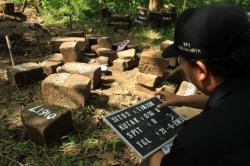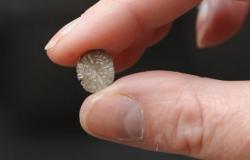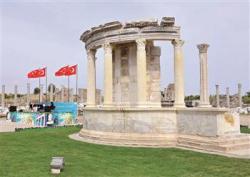INSTITUT SUPERIEUR D'ANTHROPOLOGIE
INSTITUTE OF ANTHROPOLOGY
ONLINE COURSES / COURS A DISTANCE
SUMMER TERM : JULY 2013
REGISTER NOW
INDONESIE –  Sambirejo - An excavation team from the Cultural Heritage Preserve Agency (BPCB) Yogyakarta said they found a structure believed to be Tinjon Temple, a 9th century Hindu temple, in Sambirejo village, Prambanan, Yogyakarta. “From the excavation, we know that Tinjon Temple has a quadrangle shape,” Wahyu Astuti of the BPCB Yogyakarta told The Jakarta Post on Tuesday afternoon. She said the team could be sure of the shape of the Tinjon Temple after excavating a 30 x 30 meters-wide of land area. Assisted by 10 archaeology students from Gadjah Mada University, the team found piles of andesite rocks sized 20 x 15 centimeters each on average. Local residents of Sambirejo village have long known the presence of an archaeological structure they later named Tinjon Temple.::The temple is located around one kilometer in the western part of Ijo Temple and around two kilometers in the south of Ratu Boko Temple.:“But the main structure of the temple has yet to be found,” said Wahyu.!She said it was likely that the main structure of the temple was in the center of the complex and still buried under the ground. But it was also possible that Tinjon Temple only had a fence surrounding the complex and did not have a main structure, like Batur Temple. (asw/ebf)
Sambirejo - An excavation team from the Cultural Heritage Preserve Agency (BPCB) Yogyakarta said they found a structure believed to be Tinjon Temple, a 9th century Hindu temple, in Sambirejo village, Prambanan, Yogyakarta. “From the excavation, we know that Tinjon Temple has a quadrangle shape,” Wahyu Astuti of the BPCB Yogyakarta told The Jakarta Post on Tuesday afternoon. She said the team could be sure of the shape of the Tinjon Temple after excavating a 30 x 30 meters-wide of land area. Assisted by 10 archaeology students from Gadjah Mada University, the team found piles of andesite rocks sized 20 x 15 centimeters each on average. Local residents of Sambirejo village have long known the presence of an archaeological structure they later named Tinjon Temple.::The temple is located around one kilometer in the western part of Ijo Temple and around two kilometers in the south of Ratu Boko Temple.:“But the main structure of the temple has yet to be found,” said Wahyu.!She said it was likely that the main structure of the temple was in the center of the complex and still buried under the ground. But it was also possible that Tinjon Temple only had a fence surrounding the complex and did not have a main structure, like Batur Temple. (asw/ebf)
http://www.thejakartapost.com/news/2013/05/22/ancient-hindu-temple-unearthed-prambanan.html
INDE – Shahibaugh - Imagine one of Shah Jahan's first creations — the 391-year-old Moti Shahi Palace at Shahibaugh that was built even before the Taj Mahal in 1622 AD — to have thousands of square feet of commercial space, a lift and a staircase and many of its Mughal architectural elements lost to cement and concrete structures! The Sardar Vallabhbhai Patel Memorial Trust, which is its present caretaker, has convinced the Ahmedabad Municipal Corporation (AMC) that the lone Mughal palace in western India was fit to be desecrated. The AMC has extended a no-objection certificate on April 24 for construction, subject to Gujarat high court's decision.
http://articles.timesofindia.indiatimes.com/2013-05-22/ahmedabad/39444855_1_moti-shahi-palace-ahmedabad-municipal-corporation-the-amc
EGYPTE –  Antinopolis - Leading archaeologists have denounced the poor state of conservation of the Roman remains at Antinopolis in Egypt, the city built by the emperor Hadrian, who ruled Rome from 117AD to 138AD. The revolution that swept through the country in 2011 and the subsequent exit of its president, Hosni Mubarak, who is currently in jail facing corruption charges, have affected the security and conservations of many historical sights in the country, especially those that are far from major city centres. Antinopolis, located near the Nile over 30km south of the nearest large town, Minya, is a perfect target. Until recently, the Roman hippodrome there was still intact, although it has now been swallowed by the ever-expanding cemetery for the neighbouring small town called Sheikh ‘Ibada. Out of the four hippodromes built by the Romans in Egypt, this was the only one that survived. Large areas are being prepared for redevelopment and parts of the ancient necropolis on the north of the site have already been converted into farmland. A vast expanse of ancient ruins, Antinopolis extends eastwards from the small of Sheikh ‘Ibada, and much of the Roman wall that circles the ancient city are still visible. Antinopolis has been an important source of artefacts of Egypt’s early Christian period, many of which are now housed in antiquities museums around the world.
Antinopolis - Leading archaeologists have denounced the poor state of conservation of the Roman remains at Antinopolis in Egypt, the city built by the emperor Hadrian, who ruled Rome from 117AD to 138AD. The revolution that swept through the country in 2011 and the subsequent exit of its president, Hosni Mubarak, who is currently in jail facing corruption charges, have affected the security and conservations of many historical sights in the country, especially those that are far from major city centres. Antinopolis, located near the Nile over 30km south of the nearest large town, Minya, is a perfect target. Until recently, the Roman hippodrome there was still intact, although it has now been swallowed by the ever-expanding cemetery for the neighbouring small town called Sheikh ‘Ibada. Out of the four hippodromes built by the Romans in Egypt, this was the only one that survived. Large areas are being prepared for redevelopment and parts of the ancient necropolis on the north of the site have already been converted into farmland. A vast expanse of ancient ruins, Antinopolis extends eastwards from the small of Sheikh ‘Ibada, and much of the Roman wall that circles the ancient city are still visible. Antinopolis has been an important source of artefacts of Egypt’s early Christian period, many of which are now housed in antiquities museums around the world.
http://www.theartnewspaper.com/articles/The+battle+for+Egypt%E2%80%99s+ancient+Roman+site,+Antinopolis/29604
BERMUDES –  Smith’s Island - A team of visiting archaeologists from New York’s University of Rochester returns to Smith’s Island this summer hoping to uncover artifacts associated with Bermuda’s first three permanent residents as well as enslaved 17th century Native Americans and Africans. Headed by Dr. Michael Jarvis and working on Smith’s Island since 2010, the team believes they may have identified the precise location where the “Three Kings of Bermuda” — Christopher Carter, Edward Waters and Edward Chard — lived between 1610 and 1612. The 61 acre island is located near the northern entrance to St. George’s Harbour and has long been known to have been the site of Bermuda’s first permanent settlement, with Carter, Waters and Chard building rough cabins there. Members of the “Sea Venture” party wrecked in Bermuda, the three men elected to stay behind in Bermuda in 1610 after the Bermuda-built ships “Patience” and “Deliverance” carried the castaways to the English settlement at Jamestown in Virginia. After some 20 months, the reign of the “Three Kings” came to an end with the arrival of the “Plough” in July, 1612 carrying Richard Moore — Bermuda’s first Governor — and a party of 60 settlers.
Smith’s Island - A team of visiting archaeologists from New York’s University of Rochester returns to Smith’s Island this summer hoping to uncover artifacts associated with Bermuda’s first three permanent residents as well as enslaved 17th century Native Americans and Africans. Headed by Dr. Michael Jarvis and working on Smith’s Island since 2010, the team believes they may have identified the precise location where the “Three Kings of Bermuda” — Christopher Carter, Edward Waters and Edward Chard — lived between 1610 and 1612. The 61 acre island is located near the northern entrance to St. George’s Harbour and has long been known to have been the site of Bermuda’s first permanent settlement, with Carter, Waters and Chard building rough cabins there. Members of the “Sea Venture” party wrecked in Bermuda, the three men elected to stay behind in Bermuda in 1610 after the Bermuda-built ships “Patience” and “Deliverance” carried the castaways to the English settlement at Jamestown in Virginia. After some 20 months, the reign of the “Three Kings” came to an end with the arrival of the “Plough” in July, 1612 carrying Richard Moore — Bermuda’s first Governor — and a party of 60 settlers.
http://bernews.com/2013/05/archaeological-team-returns-to-smiths-island/
FRANCE –  Bourguébus - Un site majeur des I er et II e siècles avant notre ère est fouillé près de Caen, par des archéologues de l'Inrap, pendant deux mois. Repéré par des photos aériennes dès 1995, il aura fallu attendre avril dernier pour que débutent les fouilles de cet important site archéologique. À Bourguébus, près de Caen, une dizaine d'archéologues de l'Institut national de recherches archéologiques préventives (Inrap) reconstitue l'histoire d'une résidence aristocratique datant de - 250 à - 100 avant J.-C. Cette forteresse gauloise se distingue par ses dimensions. « Les trois hectares que nous fouillons ne sont que les fortifications de ce domaine pouvant atteindre 20 ha, soit la taille d'une petite ville à l'époque », explique Anthony Lefort, responsable de l'opération, prescrite de début avril jusqu'au 24 mai. Les archéologues ont révélé de puissants fossés de 4 m de profondeur pour 6 m de large, délimitant la place forte. « Il faut imaginer des douves et un imposant rempart de plusieurs mètres de hauteur, empêchant toute intrusion. » Peu de sites gaulois de telle ampleur sont connus en France. Pour les archéologues, ce château gaulois devait accueillir un seigneur, sa famille et sa cour, soit jusqu'à 150 personnes. Il était vraisemblablement le siège d'un vaste territoire constellé de fermes et de domaines agricoles. Outre la fortification, les archéologues ont mis au jour des fragments de crânes humains, des céramiques luxueuses, des reliques d'ancêtres, une lance et un fourreau d'épée. « Nous avons retrouvé peu d'objets, ce qui laisse penser que le château a été abandonné volontairement par ses propriétaires, peut-être pour partir s'installer en ville ou dans une autre demeure », souligne Anthony Lefort. Les recherches sur le terrain laisseront bientôt place au travail en laboratoire. Un rapport devrait être remis dans environ un an.
Bourguébus - Un site majeur des I er et II e siècles avant notre ère est fouillé près de Caen, par des archéologues de l'Inrap, pendant deux mois. Repéré par des photos aériennes dès 1995, il aura fallu attendre avril dernier pour que débutent les fouilles de cet important site archéologique. À Bourguébus, près de Caen, une dizaine d'archéologues de l'Institut national de recherches archéologiques préventives (Inrap) reconstitue l'histoire d'une résidence aristocratique datant de - 250 à - 100 avant J.-C. Cette forteresse gauloise se distingue par ses dimensions. « Les trois hectares que nous fouillons ne sont que les fortifications de ce domaine pouvant atteindre 20 ha, soit la taille d'une petite ville à l'époque », explique Anthony Lefort, responsable de l'opération, prescrite de début avril jusqu'au 24 mai. Les archéologues ont révélé de puissants fossés de 4 m de profondeur pour 6 m de large, délimitant la place forte. « Il faut imaginer des douves et un imposant rempart de plusieurs mètres de hauteur, empêchant toute intrusion. » Peu de sites gaulois de telle ampleur sont connus en France. Pour les archéologues, ce château gaulois devait accueillir un seigneur, sa famille et sa cour, soit jusqu'à 150 personnes. Il était vraisemblablement le siège d'un vaste territoire constellé de fermes et de domaines agricoles. Outre la fortification, les archéologues ont mis au jour des fragments de crânes humains, des céramiques luxueuses, des reliques d'ancêtres, une lance et un fourreau d'épée. « Nous avons retrouvé peu d'objets, ce qui laisse penser que le château a été abandonné volontairement par ses propriétaires, peut-être pour partir s'installer en ville ou dans une autre demeure », souligne Anthony Lefort. Les recherches sur le terrain laisseront bientôt place au travail en laboratoire. Un rapport devrait être remis dans environ un an.
http://www.ouest-france.fr/2013/05/21/calvados/Un-important-chateau-gaulois-mis-au-jour--65190075.html
ROYAUME UNI –  Lewes - A historic coin that dates back more than 700 years has been excavated at an archaeological dig. The oval-shaped silver farthing measures 12mm by 10mm and dates back to around 1300 to 1310. Because the coin was issued during the transition between the last years of Edward I’s reign and the start of Edward II’s reign, researchers initially struggled to attribute it to the correct king. But by using special identification techniques, like assessing what type of crown the king was wearing and the style of lettering on the coin’s inscriptions, experts believe the coin dates from the last seven years of Edward I’s reign, from 1300 to 1307. Stephanie Smith, the society’s finds liaison officer, said the coin was probably dropped during everyday activity outside the town and not at the Battle of Lewes, which took place nearly 40 years earlier. She said: “There are transitional issues between Edward I and the earliest coins issued by Edward II. “The portraits on the coins are similar to each other so they can be difficult to identify. “Some have inner circles, particular crowns, a particular way the hair is positioned and how they abbreviated their names and titles in the inscriptions.
Lewes - A historic coin that dates back more than 700 years has been excavated at an archaeological dig. The oval-shaped silver farthing measures 12mm by 10mm and dates back to around 1300 to 1310. Because the coin was issued during the transition between the last years of Edward I’s reign and the start of Edward II’s reign, researchers initially struggled to attribute it to the correct king. But by using special identification techniques, like assessing what type of crown the king was wearing and the style of lettering on the coin’s inscriptions, experts believe the coin dates from the last seven years of Edward I’s reign, from 1300 to 1307. Stephanie Smith, the society’s finds liaison officer, said the coin was probably dropped during everyday activity outside the town and not at the Battle of Lewes, which took place nearly 40 years earlier. She said: “There are transitional issues between Edward I and the earliest coins issued by Edward II. “The portraits on the coins are similar to each other so they can be difficult to identify. “Some have inner circles, particular crowns, a particular way the hair is positioned and how they abbreviated their names and titles in the inscriptions.
http://www.theargus.co.uk/news/10438112.How_s_that_for_some_change__Archaeologists_discover_700_year_old_coin_in_Lewes_dig/?ref=rss
TURQUIE –  Side - The 1,800-year-old Tyche Shrine in Side has been restored and opened to visitors with a ceremony attracting a number of senior figures.
Side - The 1,800-year-old Tyche Shrine in Side has been restored and opened to visitors with a ceremony attracting a number of senior figures.
http://www.hurriyetdailynews.com/tyche-shrine-opens-again-following-long-restoration.aspx?pageID=238&nID=47219&NewsCatID=375